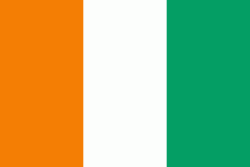San Pédro (San-Pédro)
San-Pédro is a city in southwestern Ivory Coast. It is the nation's second largest port and the seat of Bas-Sassandra District and San-Pédro Region. It is also a commune and the seat of and a sub-prefecture of San-Pédro Department. In the 2014 census, the city had a population of 164,944, making it the sixth-largest city in the country. The city is served by San Pédro Airport.
Northwest of the city lies the Taï National Park, known as one of the last sanctuaries of the pygmy hippopotamus, which is listed on the UNESCO's World Heritage List.
Largely developed from the 1960s, fishing is an important industry, while the town is known for its nightlife and its beaches.
Northwest of the city lies the Taï National Park, known as one of the last sanctuaries of the pygmy hippopotamus, which is listed on the UNESCO's World Heritage List.
Largely developed from the 1960s, fishing is an important industry, while the town is known for its nightlife and its beaches.
Map - San Pédro (San-Pédro)
Map
Country - Côte_d'Ivoire
 |
 |
| Flag of Ivory Coast | |
Before its colonization by Europeans, Ivory Coast was home to several states, including Gyaaman, the Kong Empire, and Baoulé. The area became a protectorate of France in 1843 and was consolidated as a French colony in 1893 amid the European Scramble for Africa. It achieved independence in 1960, led by Félix Houphouët-Boigny, who ruled the country until 1993. Relatively stable by regional standards, Ivory Coast established close political-economic ties with its West African neighbours while maintaining close relations with the West, especially France. Its stability was diminished by a coup d'état in 1999, then two civil wars—first between 2002 and 2007 and again during 2010–2011. It adopted a new constitution in 2016.
Currency / Language
| ISO | Currency | Symbol | Significant figures |
|---|---|---|---|
| XOF | West African CFA franc | Fr | 0 |
| ISO | Language |
|---|---|
| FR | French language |















